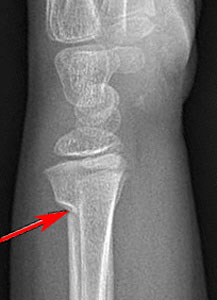
Suspected hand and wrist fractures warrant emergent treatment if your child is experiencing hand numbness and tingling, severe Yes! Some fractures are obvious if there is a deformity, but typically X-ray is used to definitively diagnose the fracture and plan treatment. Is There a Test for Hand and Wrist Fractures? Finger hyperextension / jamming injuries.Direct blows to the hand or wrist (sports, vehicle accidents).Fall onto an outstretched hand (most common).Most hand and wrist fractures in children are caused by injuries:

The fractures occur around the soft growth plates at the wrist and bases of the fingers. Because children’s bones are more flexible than adults’, sometimes they “bend” or “buckle” like a “green stick” rather than cracking. These are all just different ways of describing a fracture. You’ve been told the bone was “broken”, “hairline”, “green stick”, “buckled”, “cracked”, “chipped”, “split”, “shattered”, or “splintered”, Fractures are simply breaks or cracks in the bone. Unfortunately, fractures are a right-of-passage for most children. Of all ages, and when they land on their outstretched hand or wrist, injuries can occur. Kids are active, but not always graceful! Falls happen to children Statistical data in this article was reviewed by the AAOS Department of Research and Scientific Affairs.What Are Pediatric Hand and Wrist Fractures? Your doctor may recommend follow-up visits for up to one year to ensure that growth is proceeding normally. If the fracture disrupts the growth plate at the end of the bone, it could affect the development of the bone. To allow the bones to safely regain their normal strength, the child should avoid playing on playground structures, such as monkey bars, for 3 to 4 weeks after the cast is removed. This stiffness will go away on its own, usually without the need for physical therapy.įor a short period of time, the forearm bones may be weaker due to immobilization in the cast. When the cast is removed, the wrist and elbow joints may be stiff for 2 to 3 weeks. A more serious injury, such as a Monteggia fracture, may need to be immobilized for 6 to 10 weeks. A stable fracture, such as a buckle fracture, may require 3 to 4 weeks in a cast. The length of time the cast is worn will vary depending on the severity of the fracture. Because the growth plate helps determine the future length and shape of the mature bone, this type of fracture requires prompt attention. In most cases, this type of fracture occurs in the growth plate of the radius near the wrist. Also called a "physeal" fracture, this fracture occurs at or across the growth plate. This is a very severe injury and requires urgent care. There is usually a fracture in the ulna and the top (head) of the radius is dislocated. This injury affects both bones of the forearm. There is usually a displaced fracture in the radius and a dislocation of the ulna at the wrist, where the radius and ulna come together.

The fracture extends through a portion of the bone, causing it to bend on the other side. The fracture is across the upper or lower portion of the shaft of the bone and does not affect the growth plate. This is a stable fracture, meaning that the broken pieces of bone are still in position and have not separated apart (displaced). The topmost layer of bone on one side of the bone is compressed, causing the other side to bend away from the growth plate. There are several types of forearm fractures in children:


 0 kommentar(er)
0 kommentar(er)
